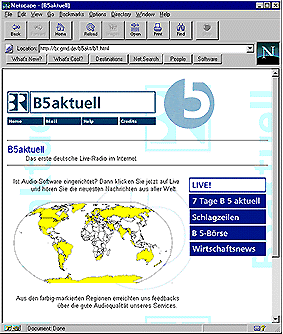Personal R@dio: Audio on Demand on the Internet
by Peter Kanzow and Ralf Wegner
'Bayerischer Rundfunk', a major public German broadcaster, and GMD in co-operation with two of GMD spin-off companies (gekko and Digital Media Consulting & Services, DMC) presented in 1996 the first ever Live German Internet Radio, called 'PersonalR@dio'. Meanwhile Personal-R@dio has been re-designed, and a new section, called 'CollegeR@dio', with multi-medial content has been added.
PersonalR@dio consists of two parts:
- B5 Aktuell, the information channel of the Bayerischer Rundfunk, is implemented as the first ever comprehensive interactive radio application on the net. The radio programme is not only re-broadcasted into the Internet simultaneously with the terrestrial broadcast, but is also stored in a digital audio archive which is updated continuously and fully automatic. The whole programme of one week may be selected and called as desired on the World Wide Web. The live signal as well as the archived data is understandably available across the globe, where many German expatriates listeners have expressed their delight through many electronic mails. The technique used in automating the named archive belongs to a group of applications developed by GMD which no doubt plays an important role in any future internet broadcasting technology.
- The second part of PersonalR@dio, called CollegeR@dio, is the Educational and School programme version of the Bayerischer Rundfunk on the internet. The idea behind this broadcasting concept is that a vaster group of students and pupils may access the information which is transmitted in the form of text, audio and pictures.
Equally interesting are the number of hyperlinks for any subject that may be connected directly through these sites. Therefore it is plausible to present an extensive set of information such as literature, graphics (eg maps for geography and history students), audio files for languages to access on the Internet.
How does PersonalR@dio work?
Contrary to many other audio applications on the internet where the material has to first be downloaded and the played, PersonalR@dio uses the audio streaming concept. This implies that audio data are transmitted real-time such that the listener may receive them instantly through a sound system. This means that it is not necessary for all the data has to be transmitted before one hears something hence normally one can only listen to the data live. This is however where the PersonalR@dio has the interesting edge to other streaming radios, as one can access the information also through archive possibilities. In addition the receiving qualities also may be altered as desired.
The normal Internet bandwidth is currently limited owing to various bottle-necks which exist when passing through several gateways. A typical Internet modem user has a maximum data rate of 14,4 kilobit per second hence setting an upper limit for any application development for the public.
The B5 Aktuell audio signal which is received through Astra Satellite in GMD, Sankt Augustin, is further directed to a 11 kilobit per second encoder into the Internet. Audio quality is comparable to short wave radio and provides a cheap alternative for terrestrial broadcast. Simultaneously the audio stream is collected and stored on a server's hard disk. The automated updating of the websites enables the data to be upgraded into appropriate position and hence to be accessed on-demand through the archive.

PersonalR@dio web interface.
CollegeR@dio has also the same technical concept, with a streaming capability
of 11 kilobit per second. In order to reduce undesirable parasites (eg
bad acoustics, high noise, low quality equipment) CollegeR@dio materials
with better audio quality (32 kilobit per second) is also available for
download.
What does the end user need to receive
PersonalR@dio? To receive Personal-R@dio one needs a Personal Computer (Windows 3.x/95, Linux), a Power Mac or a Unix Workstation with Internet access (Modem or ISDN) and a sound card. The necessary software is of course a World Wide Web browser (eg Netscape Navigator) and an audio streaming player which can be downloaded freely on the internet.
The World Wide Web address of PersonalR@dio is: http://www.br.gmd.de/. The streaming player may be downloaded from its vendor's on http://www.xingtech.com/ but is also available at the PersonalR@dio Web site for a faster download in Germany.
Please contact:
Peter Kanzow - GMD
Tel: +49 2241 14 2672
E-mail: peter.kanzow@gmd.de
